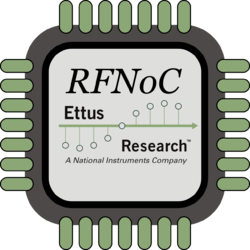Difference between revisions of "RFNoC (UHD 3.0)"
From Ettus Knowledge Base
(→RFNoC Resources) |
(organizing and updating resource links at the bottom) |
||
| Line 9: | Line 9: | ||
* X300/X310 | * X300/X310 | ||
| − | ==Available Blocks== | + | ==Sample of Available Blocks== |
*FIFO | *FIFO | ||
*FFT | *FFT | ||
| Line 20: | Line 20: | ||
*Window multiplier (for FFT) | *Window multiplier (for FFT) | ||
*OFDM: Burst detection + synchronization, equalizer, packet demodulator | *OFDM: Burst detection + synchronization, equalizer, packet demodulator | ||
| + | *and more... | ||
==RFNoC Resources== | ==RFNoC Resources== | ||
| − | + | 2016 | |
| + | *[[Getting_Started_with_RFNoC_Development|Getting Started with RFNoC Development with PyBOMBS]] | ||
| + | *[[RFNoC Getting Started Guides|Getting Started with RFNoC Development]] | ||
| + | *[https://drive.google.com/file/d/0B6ccrJyAZaq3MTRDbmVUR0gwVU0/view GNU Radio 2016 Conference Presentation] | ||
| − | https://www.youtube.com/watch?v=8cPd3t88djE | + | 2015 |
| + | *[https://www.youtube.com/watch?v=8cPd3t88djE Virginia Tech Video Presentation] | ||
| − | http://conferences.sigcomm.org/sigcomm/2013/papers/srif/p45.pdf | + | 2013 |
| + | *[http://conferences.sigcomm.org/sigcomm/2013/papers/srif/p45.pdf sigcom 2013 Paper] | ||
Revision as of 14:14, 8 December 2016
Overview
Supported Devices
- E310/E312
- X300/X310
Sample of Available Blocks
- FIFO
- FFT
- FIR
- fosphor (real-time spectrum analyzer)
- Decimator (Keep 1 in N)
- Log Power Calculator
- Radio Interface
- Vector IIR (moving average)
- Window multiplier (for FFT)
- OFDM: Burst detection + synchronization, equalizer, packet demodulator
- and more...
RFNoC Resources
2016
- Getting Started with RFNoC Development with PyBOMBS
- Getting Started with RFNoC Development
- GNU Radio 2016 Conference Presentation
2015
2013

